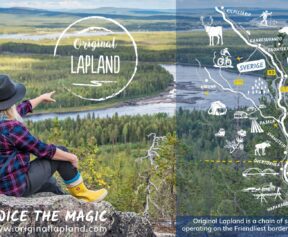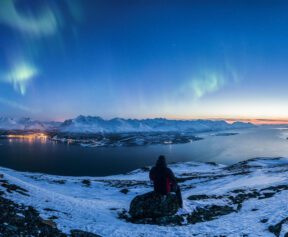See the text in the original language
Alpo Vuontisjärvi from Enontekiö tells a true story of “Rovan Niku” (Niilo Uollonpoika Keskitalo).
Way back in 1861, the shoreline of the lake Vuontisjärvi, visible in the background, was located here – about half a metre below our current spot. We are standing right by the shore, so be careful not to get your feet wet! What happened is that the water level of the lake very suddenly dropped by six metres, reducing its size nearly by a third in terms of its surface area.
The interview is in Finnish.
Transalation: A story of how the river changed its route
This is about two stories, and one of them concerns myself. In fact, we are standing quite exactly where my grandfather was born. Sometimes in the early 20s, he moved from here to the village of Hetta, and the story of that family branch has thereafter been associated with Hetta. However, another and more interesting story is related to this lake. Way back in 1861, the shoreline of the lake Vuontisjärvi, visible in the background, was located here – about half a metre below our current spot. We are standing right by the shore, so be careful not to get your feet wet! What happened is that the water level of the lake very suddenly dropped by six metres, reducing its size nearly by a third in terms of its surface area. It was a huge upheaval, and as you can see, all the houses here are standing at the bottom of a former lake. Had they been here back in the day, they would be submerged under approximately four metres of water.
The upheaval was caused by a major farm-owner called Rovan Niku – his real name was Niilo Uollonpoika Keskitalo. At the lower end of the lake where the river originates, he had a meadow which was very dry and produced poor-quality hay. He wanted to produce better-quality hay by diverting more water to the meadow. He owned more than 10 cows and two horses, so he needed quite a lot of hay throughout the year. Over many years, whenever he didn’t have other things to do, he would dig a little ditch either from Vuontisjärvi or the mouth of the Vuontisjoki river towards his patch of land. This took up all the extra time he had.
This took place in the early summer or late spring of 1861, at the time of the spring floods. Facing a stark northern wind, he and his farm-hand were digging the ditch and were able to divert the water along the ditch towards the dry plot of land. Content, they went to cook porridge somewhere nearby. The situation was looking good: after digging for so many years, the water was finally flowing. The northern wind gained momentum and kept pushing the water towards the mouth of the river.
As you can see, the soil is sand-based and completely rock-free. So, what happened is that the mass of water rushed and tore through these sandy ridges, forming a new riverbed and causing the old riverbed to dry up. Accompanied by tremendous rumbling, a completely new river was formed.
The villagers in Hetta, located 17 kilometres in the west and nowadays officially known as Enontekiö village, heard the massive rumble in the east. As folks back then were very religious and had read their Bible well, they remembered that the end of the world would be heralded by tremendous rumbling in the east. They were quite sure that this was the end of the world and that they would face the last judgment, so they decided to unburden themselves of their sins. People started running from house to house, revealing their hidden sins that previously were too shameful to disclose. Everybody seemed to have a fair amount of sins, so they kept running around in the village.
Apparently, after the situation cleared up, it took many months until the villagers started paying visits to each other again. It also turned out that, for three years, the water remained muddled by sand and prevented the salmon from migrating upstream. You can imagine the financial impact all of this had.
– And how many people were affected.
– Yes, all the settlements along the river were affected, and back then almost all the settlements were concentrated along the river.
In the background, you can see the old river bed at flood height. In the summer, hardly any water flows through it. The whole riverbed is completely dry. At the bottom there is a puddle, the last spot the salmon were able to reach. The rest of it was too much and they couldn’t move further. Try to imagine all the water in the current river right here, and it’s obvious that there was quite a flood 150-160 years ago. This cove must have been very deep, and the surges must have been enormous. As you can see, the water has carved a canyon over thousands or millions of years.
I do believe that the huge masses of water were gone in a couple of days. However, it took a long time for things to settle down, and it took three years for the water to clear up. After these events, it is not known whether Niku even had time to stop by his home. According to tradition, he escaped to the northern wilds. He probably spent the summer somewhere by the familiar Pöyrisjoki river all the way until autumn and the first snows. Then he had to return to the village. I suppose he did have somebody who secretly delivered him food and nets, salt and other necessities needed for survival over the summer after a hasty departure. On the other hand, Vuontisjärvi villagers were and remain very peaceful and friendly people. So, when Rovan Niku returned from the northern wilds as the first snows fell in autumn, the dust had settled to an extent that he was received with indifference if not kindness. He was able to continue a normal life because nobody thought that he had caused the incident on purpose. It was a little accident at work which also left a small mark of Rovan Niku in the landscape. Without the incident, nobody would even know who Niilo Uollonpoika Keskitalo was.
Enontekiöläinen Alpo Vuontisjärvi kertoo tosi tarinan “Rovan Nikun” (Niilo Uollonpoika Keskitalo) järvenlaskusta.
Vielä kevääseen 1861 asti Vuontisjärven vedet laskivat pitkin uomaa, joka on nykynimeltään Vanhajoki. Tuolloin tapahtui Rovan Nikun järvenlasku, jota Enontekijön kalastusalue kuvaa merkittävämmäksi ihmisen aiheuttamaksi paikalliseen kalalajistoon vaikuttaneeksi tapahtumaksi ennen Isohaaran voimalaitoksen rakentamista (joka katkaisi vaelluskalan nousun Kemijokeen). Järvenlaskun seurauksena Vuontisjärven vedet hakivat itselleen uuden lasku-uoman ja vanha joki jäi noin neljän kilometrin matkalta virattomaksi.
Country of origin: Finland





